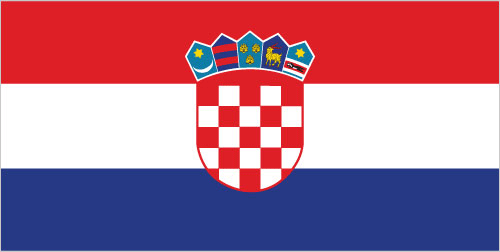Capital City: Zagreb
Population: 4,470,534 (July 2014 est)
Currency: Kuna (HRK)
Land Area: 56,594 sq km. Controls most land routes from Western Europe to Aegean Sea and Turkish Straits; most Adriatic Sea islands lie off the coast of Croatia – some 1,200 islands, islets, ridges, and rocks.
Dominant Religions: Roman Catholic 86.3%, Orthodox 4.4%, Muslim 1.5%, other 1.5%, unspecified 2.5%, not religious or atheist 3.8% (2011 est)
Land Boundaries: Bosnia and Herzegovina 932 km, Hungary 329 km, Serbia 241 km, Montenegro 25 km, Slovenia 455 km
Location: Southeastern Europe, bordering the Adriatic Sea, between Bosnia and Herzegovina and Slovenia
Climate: Mediterranean and continental; continental climate predominant with hot summers and cold winters; mild winters, dry summers along coast. Northern Croatia has a temperate continental climate whereas the central and upland regions have a mountainous climate. The entire Adriatic coast has a pleasant Mediterranean climate. Spring and autumn are mild along the coast, while winter is cold and snowy in central and northern regions. The average temperature inland in January ranges from -10° to 5°C and in August, from 19° to 39°C. The average temperature at the seaside is higher: in January, from 6°C to 11°C and in August from 21°C to 39°C
Terrain: Geographically diverse; flat plains along Hungarian border, low mountains and highlands near Adriatic coastline and islands. Geographically diverse; flat agricultural plains along the Hungarian border (Central European area), low mountains and highlands near the Adriatic coastline and islands. There are 1,246 islands; the largest ones are Krk and Cres. The highest point is Dinara, at 1,830m.
Visa: Croatia became a member of the European Union on the 1st of July 2013, however it is not part of the Schengen Area. This means that immigration controls still take place, but travellers from another EU state are exempt from customs checks. Foreign nationals of Australia can enter Croatia visa-free for up to 90 days with a passport
Entry Point: Gruda (from Sutorina, Montenegro)
Exit Point: Rupa (to Jelsane, Slovenia)
Cuisine: Croatian cuisine is quite diverse so it is hard to say what meal is most typically Croatian. In the eastern continental regions (Slavonija and Baranja) spicy sausage such as kulen or kulenova seka is a must-try. Čobanac (“shepherd’s stew”) is a mixture of several different kinds of meat with a lot of red spicy paprika. In Hrvatsko Zagorje and Central Croatia pasta filled with cheese called štrukli is a famous delicacy (it is said that the best štrukli in Croatia is served in the Esplanade Hotel restaurant in Zagreb), as is purica s mlincima (baked turkey with a special kind of pastry). Sir i vrhnje (sour cream with cottage cheese) can be bought fresh on the Zagreb main market Dolac. Croats love a bit of oil and you will find plenty of it in piroška. In mountainous regions of Lika and Gorski Kotar meals made of mushrooms, wild berries and wild meat are very popular. One of typical dishes in Lika is police (oven-baked potatoes covered with bacon) and several kinds of cheese (smoked cheese and škripavac).

